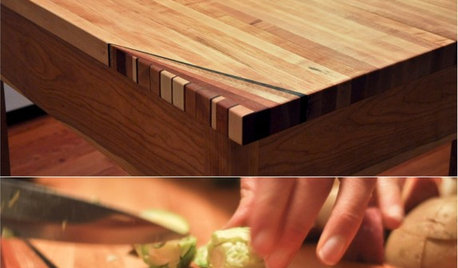Cleaning/seasoning enameled cast iron?
2ajsmama
10 years ago
Related Stories

KITCHEN DESIGNKitchen Sinks: Enameled Cast Iron for Attractive Durability
Strong, shiny and sustainable, an enameled cast iron sink can bring character to your kitchen
Full Story
HOUSEKEEPINGHow to Clean Your Cookware So It Lasts
Avoid damage during everyday cleaning and stain scrubbing, with these tips for pots and pans made of popular materials
Full Story
REMODELING GUIDESOriginal Home Details: What to Keep, What to Cast Off
Renovate an older home without regrets with this insight on the details worth preserving
Full Story
GARDENING AND LANDSCAPINGEco-Friendly Fire Pits: Casting Backyard Campfires in a New Light
Wood burning may be discouraged — even illegal in places — but that needn't mean forsaking the fire pit. Try one of these alternatives
Full Story
WOODWORKINGHow to Clean and Care for Your Butcher Block
Keep butcher block counters and boards looking sharp as a knife — and sanitized for safe food prep — with this advice from a pro woodworker
Full Story
KITCHEN DESIGNKitchen Sinks: Easy-Clean, Surprisingly Affordable Ceramic
You get a lot for the price with ceramic sinks, and they're available everywhere. See the pros and cons here
Full Story
OUTDOOR KITCHENSYour Grill Season Checklist
Get your barbecue in top shape and round up essential grilling tools to make your backyard cookouts sizzle
Full Story
HOUSEKEEPING4 Secrets to a Shiny-Clean Bathtub
Learn how to get your bathtub sparkling clean and keep it that way
Full Story
MOST POPULAR33 Magic Household Cleaning Tips
Houzzers from around the world share their tips for transforming housework into child’s play
Full Story
HOUSEKEEPINGHow to Clean Your Range and Oven
Experts serve up advice on caring for these kitchen appliances, which work extra hard during the holidays
Full Story





myfamilysfarm
2ajsmamaOriginal Author
Related Professionals
Fitchburg Landscape Architects & Landscape Designers · Seabrook Landscape Architects & Landscape Designers · Cedar Hill Landscape Contractors · North Canton Landscape Contractors · Pine Hills Landscape Contractors · Pueblo West Landscape Contractors · Wailuku Landscape Contractors · St. Louis Roofing & Gutters · Manassas Roofing & Gutters · Murray Roofing & Gutters · South Orange Roofing & Gutters · Oceanside Driveway Installation & Maintenance · Barrington Driveway Installation & Maintenance · Rehoboth Driveway Installation & Maintenance · Thornton Driveway Installation & Maintenancecalliope
NilaJones
wertach zone 7-B SC
2ajsmamaOriginal Author
wertach zone 7-B SC
NilaJones
2ajsmamaOriginal Author
nobananas